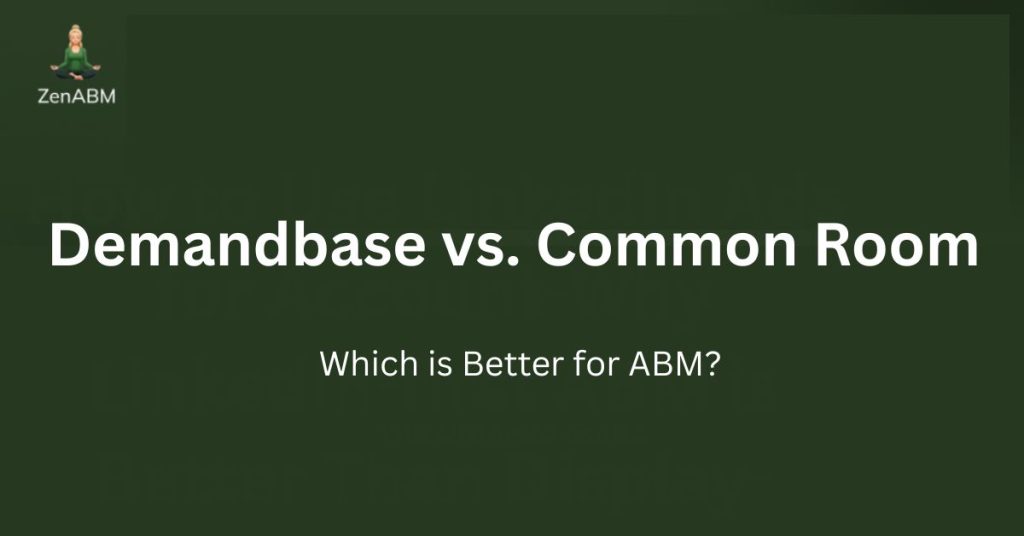In this article, I have put Demandbase vs. Common Room side by side across features, pricing, and best-fit scenarios so marketing and sales teams can decide which platform supports their account-based marketing strategy.
I’ll also walk through how ZenABM can act as a lean substitute or a complementary layer alongside these enterprise ABM suites.
Let’s dive in!
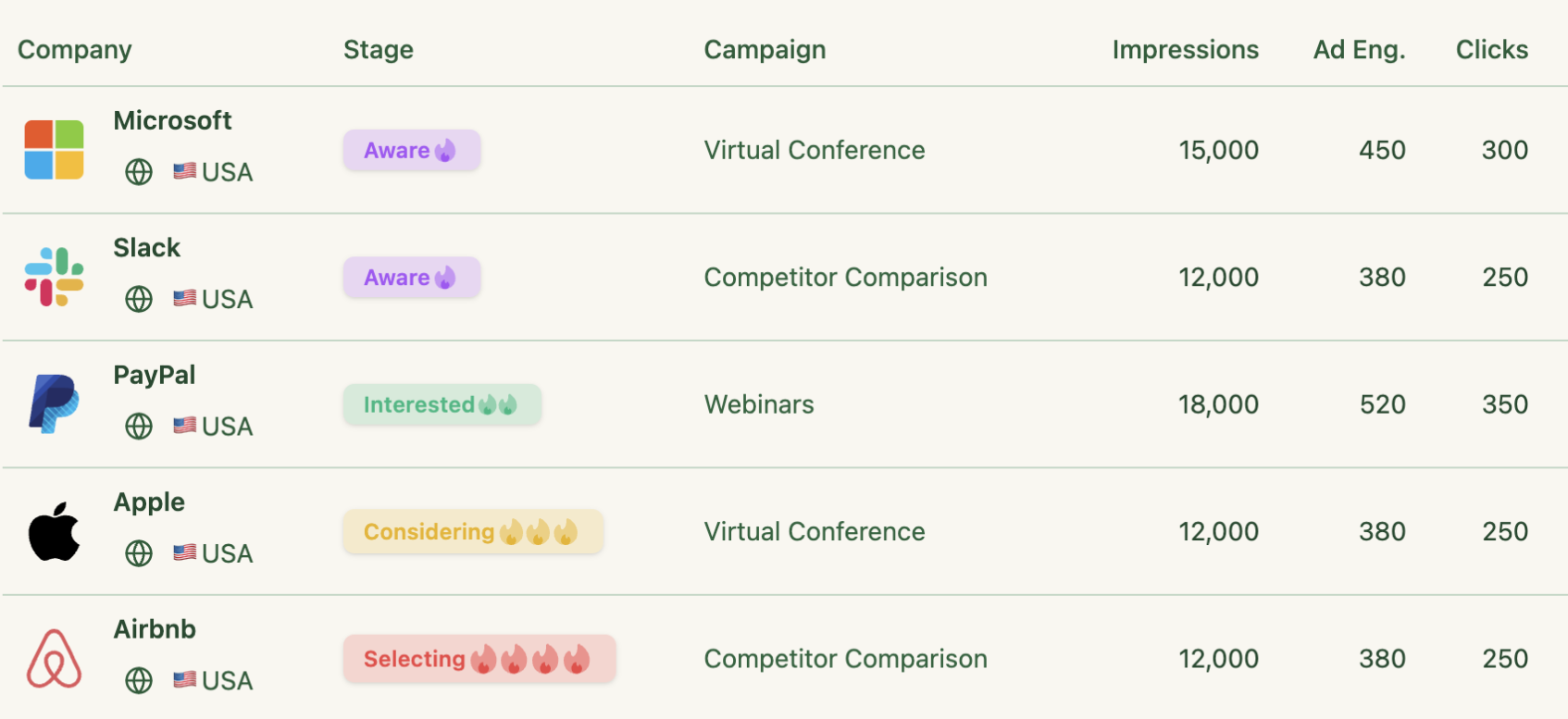
Demandbase vs. Common Room: Quick Summary
In case you’re short on time, here’s a quick overview:
Demandbase = Enterprise Full Stack ABM
- Handles the full journey from account selection to cross-channel advertising and tailored web experiences.
- Strong in pipeline attribution, intent data, and orchestration across marketing, sales, and advertising teams.
- Pricing: Custom enterprise quotes (~$62K median per year). Powerful, yet pricey and complex for smaller organizations.
Common Room = Signal and Intent Intelligence
- Centers on community, product usage, and social signals rather than media execution.
- AI-driven identity resolution (Person360) plus a scoring engine (RoomieAI).
- Ideal for teams that want to unify dark-funnel behavior with real engagement data.
- Pricing: Clear tiers — about ~$12K to ~$30K per year, custom for enterprise.
Key Difference:
- Demandbase = end to end GTM orchestration.
- Common Room = deep behavioral and community insight.
- Demandbase fits enterprise ABM, while Common Room fits signal-first, lean GTM teams.
ZenABM = Lean LinkedIn First ABM Option
- Captures first-party intent directly from LinkedIn Ads without cookies or IP guessing.
- Real-time account scoring, CRM sync (HubSpot and Salesforce), and automated intent tagging.
- Pricing starts at $59 per month, suitable for startups, mid market, and enterprise teams running LinkedIn led ABM.
Demandbase Overview: Key Features, Pricing, and More
Demandbase functions as a comprehensive ABM platform that covers everything from building target account lists to running multi-channel advertising and customizing on-site experiences.
Its broad toolkit allows teams to consolidate multiple point solutions into a single system, reducing operational friction that comes with managing many separate tools.
Demandbase also unifies account and contact data to strengthen sales intelligence, enrichment, and outbound strategy, so ABM execution improves.
Key Demandbase capabilities explained:
Target Account Identification
Demandbase helps you create and tune target account lists by combining first-party and third-party data, with AI suggestions that consider firmographics, technographics, and intent signals.
This makes it simpler for larger organizations to select the right accounts to prioritize.
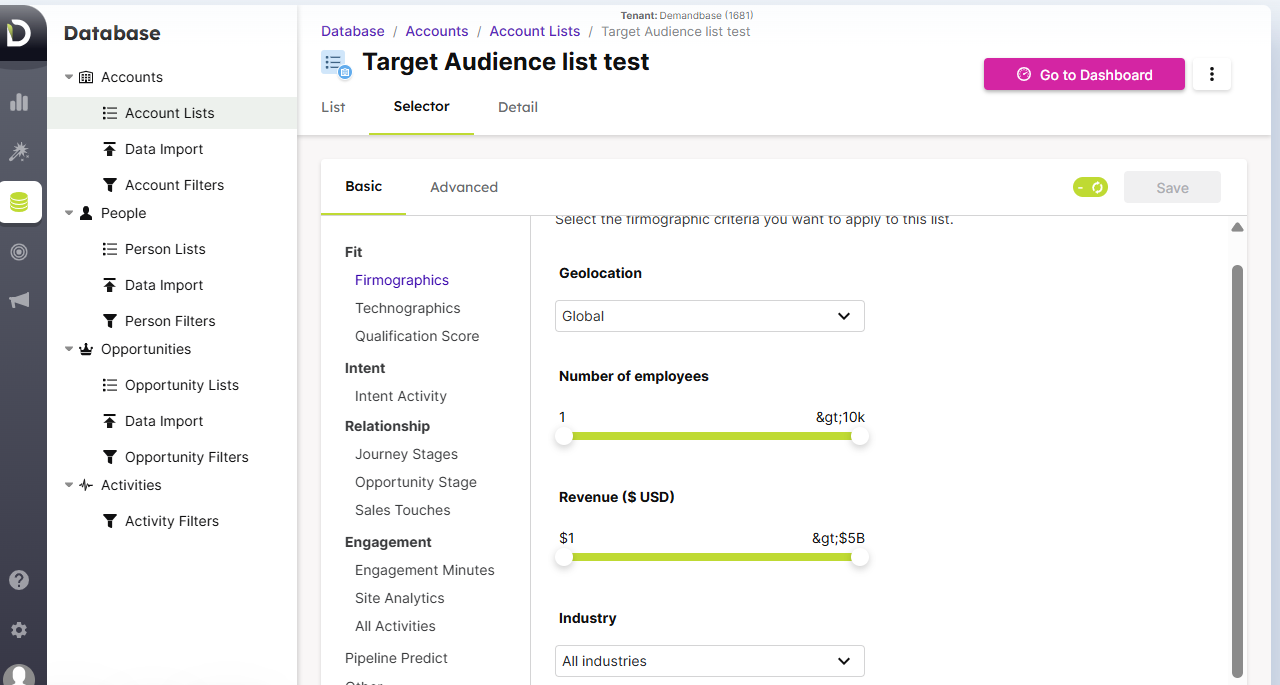

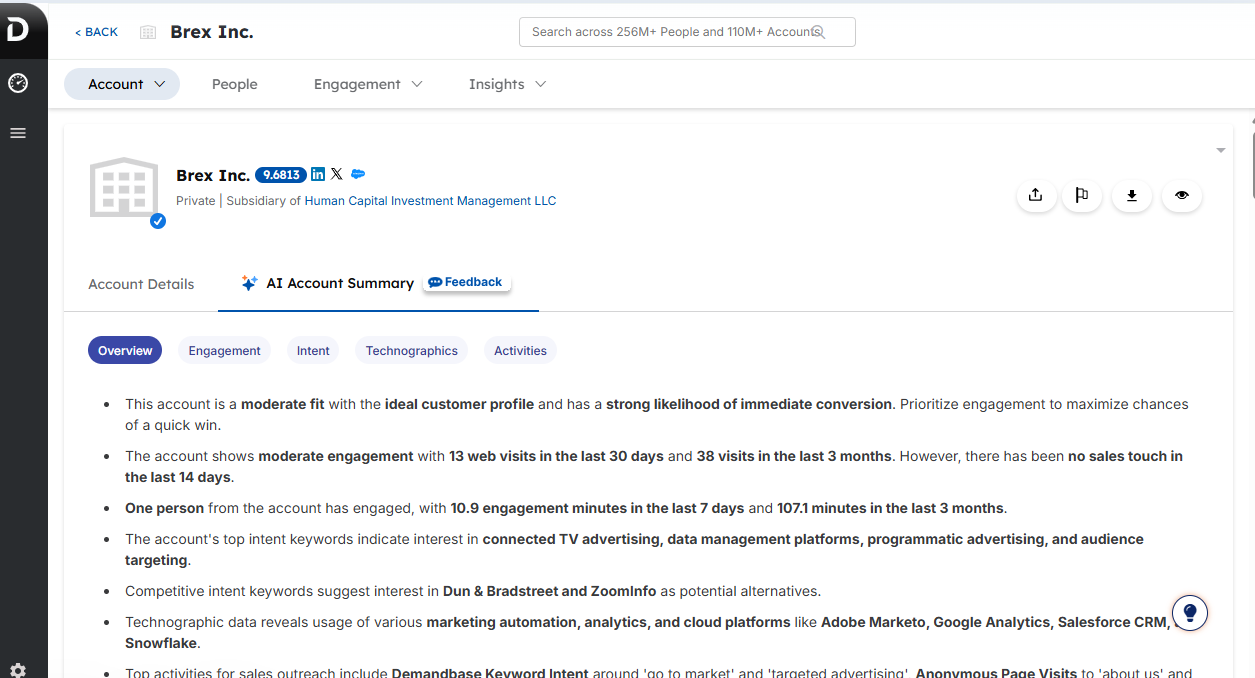
Multi-Channel Advertising with Native DSP
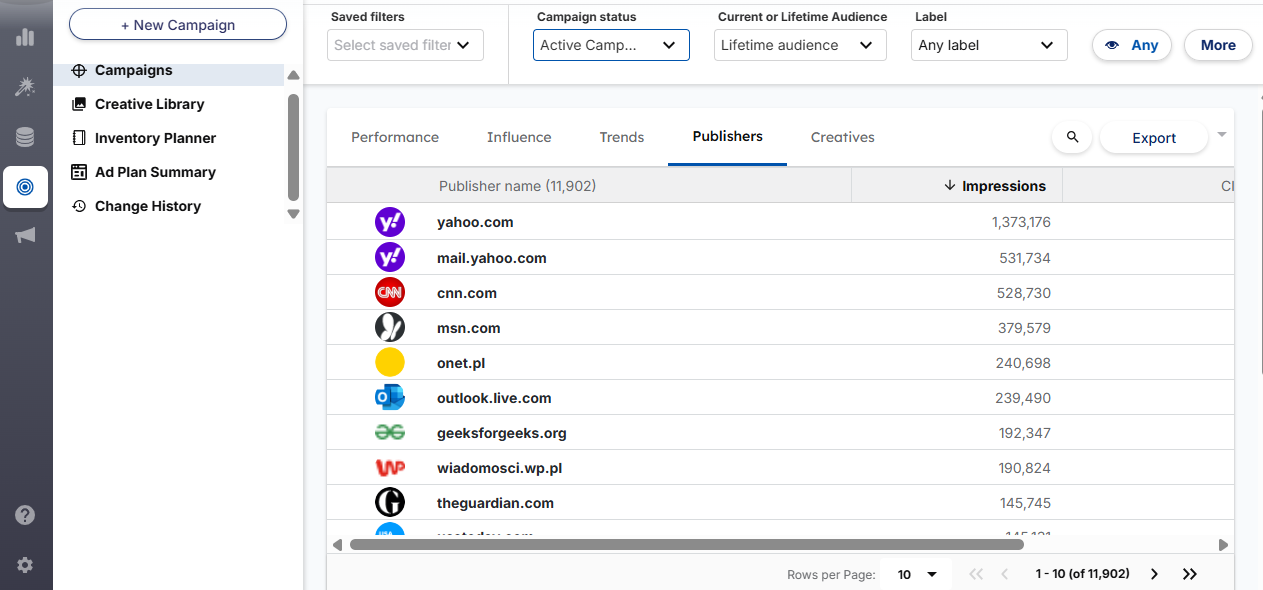
Demandbase includes a native programmatic engine so you can run display, retargeting, native, and Connected TV campaigns inside one environment. The built in DSP supports precise account targeting across channels and uses intent data to reach high value audiences.
It also connects to major social networks. You can manage LinkedIn, Facebook, Twitter, and YouTube within Demandbase, set account level frequency caps, and apply AI for budget optimization.
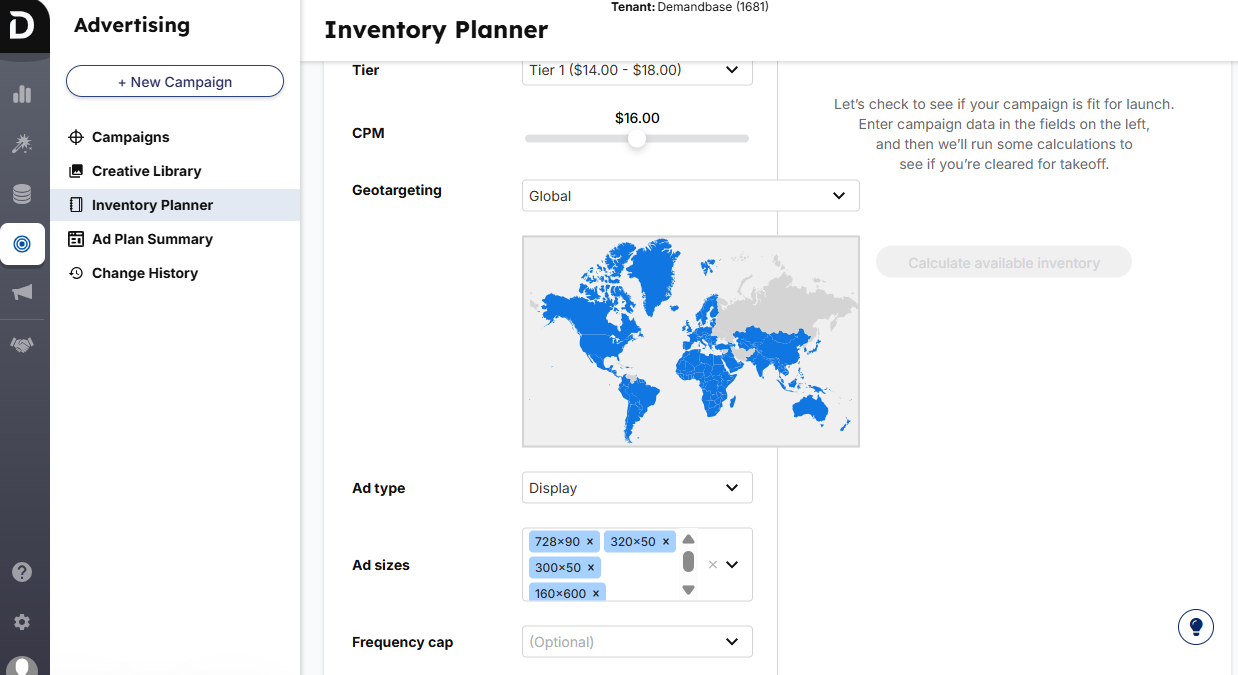
Web Personalization
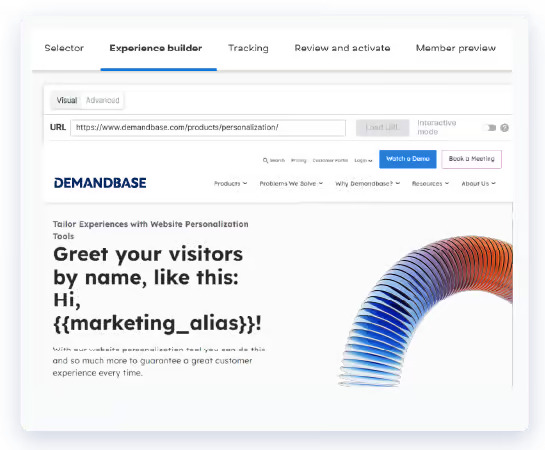
Demandbase supports personalized site experiences for target accounts.
You can create account-specific pages or dynamic modules, such as greetings and targeted offers tied to an industry or funnel stage.
Account Intelligence & Third-Party Intent
Demandbase pulls in third-party intent across more than 62,500 B2B topics and blends it with first-party engagement.
That enables Demandbase to surface target accounts that are “surging” on relevant themes across the web via providers like Bombora, in addition to how those accounts interact with your assets.
You also get heatmaps and engagement scores for a complete view of interest across channels. Beyond that, Demandbase applies predictive analytics and predictive marketing to identify in market accounts and tailor outreach so sales and marketing can focus on the best opportunities.
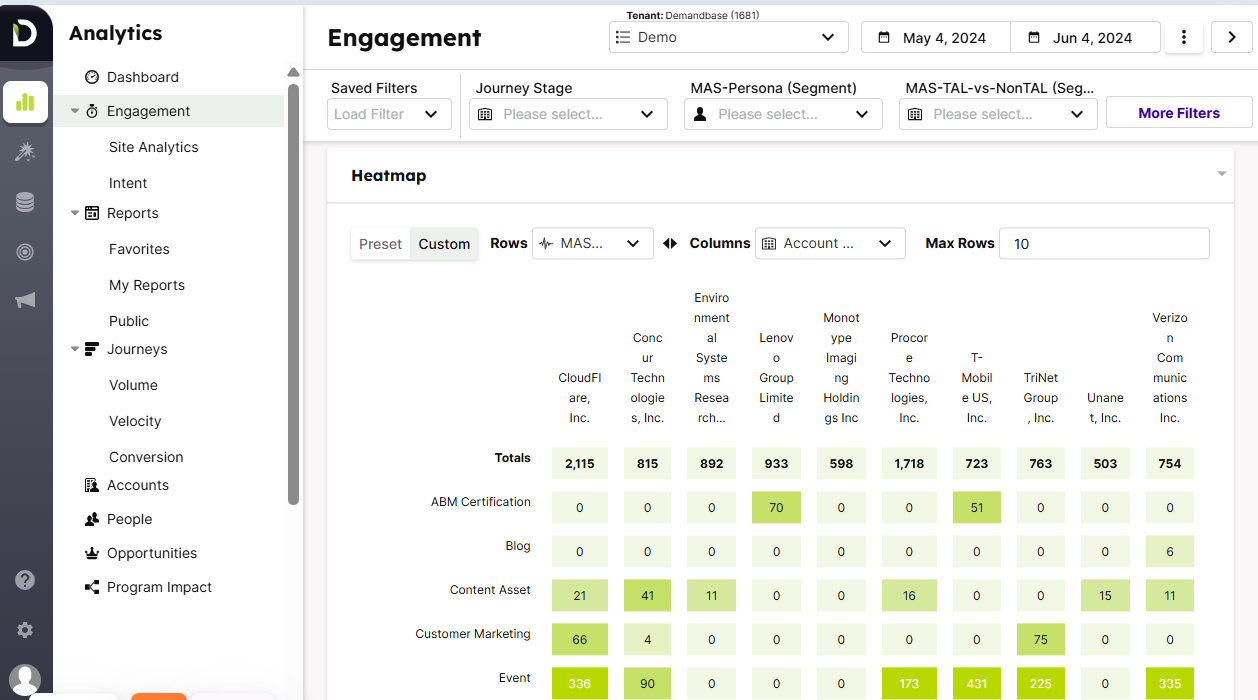
People-Based Targeting
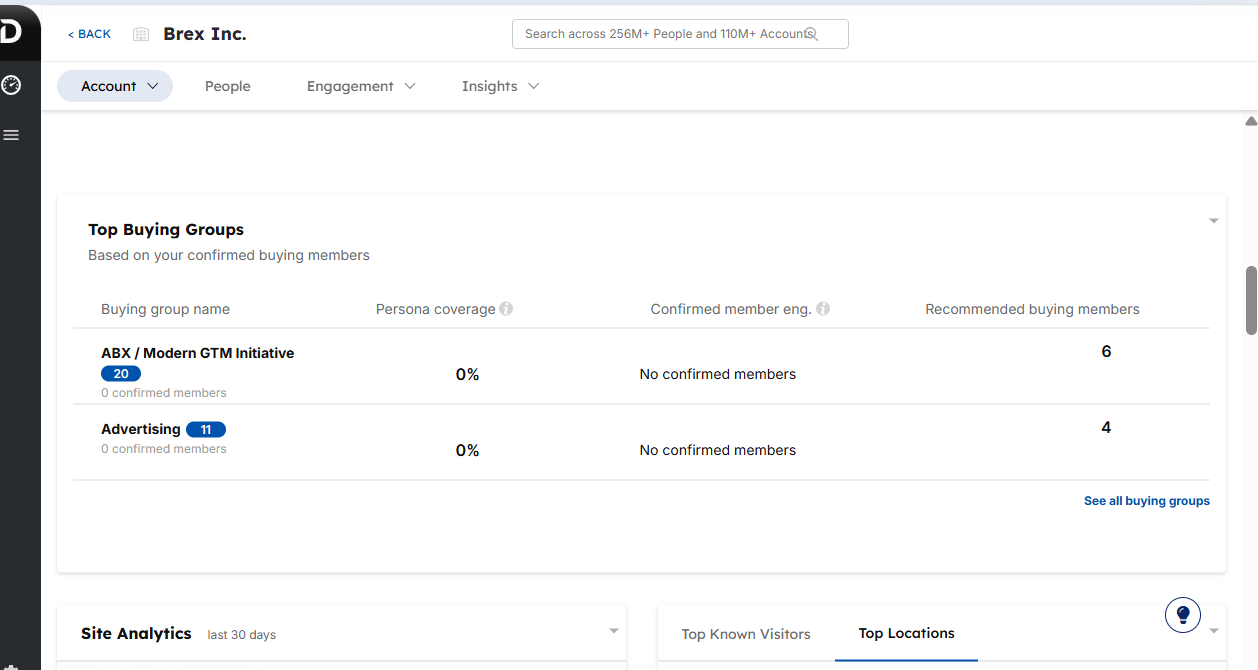
The platform builds buying committees by finding and targeting decision makers at each account and lets you aim ads or sales motions at specific roles, such as CMOs, so the right personas receive the message.
Analytics and Attribution
Demandbase delivers robust reporting to measure account engagement, campaign influence on pipeline, and revenue attribution, with visibility across the full journey.
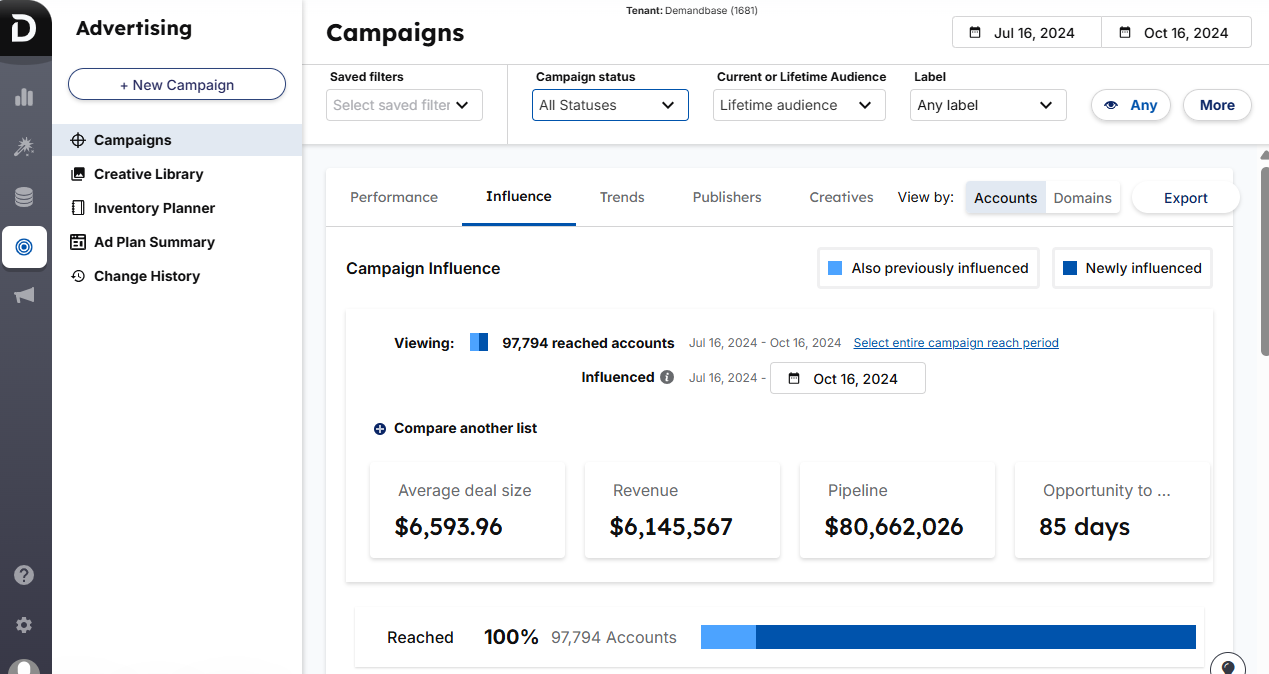
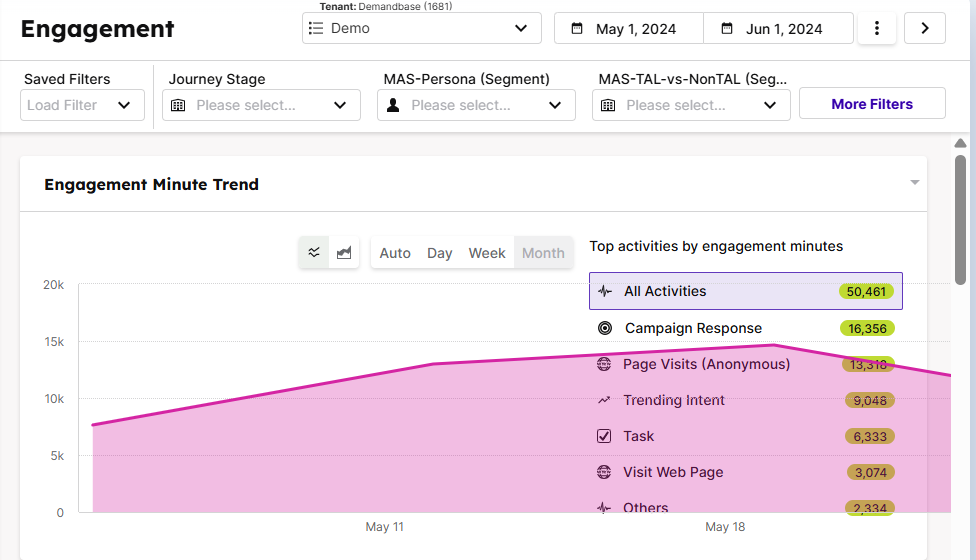
AI models estimate likely pipeline outcomes and highlight where reps should focus to improve win probability.

Remember: Ongoing management of these dashboards is essential to realize the full value.
Integrations and Ecosystem
Demandbase integrates with leading CRMs like Salesforce, marketing automation platforms (MAPs), and sales tools so account insights flow directly into sales workflows, for example, via a Salesforce component that shows engagement. It also connects with popular sales engagement tools like Outreach and Salesloft to fit into most stacks and reduce friction.
This alignment ensures marketing and sales operate from the same source of truth.
For the full catalog, see the Demandbase official docs.
Demandbase Pricing
Demandbase does not publish list prices and typically offers custom enterprise packages after a conversation with sales.
Most deals include a platform fee plus per seat pricing, and costs rise with team size. Usage can also influence pricing, including engaged account volume, activity levels, and how many people log in.
According to industry references:
- The median annual price for Demandbase One is roughly $65,000, per Vendr:
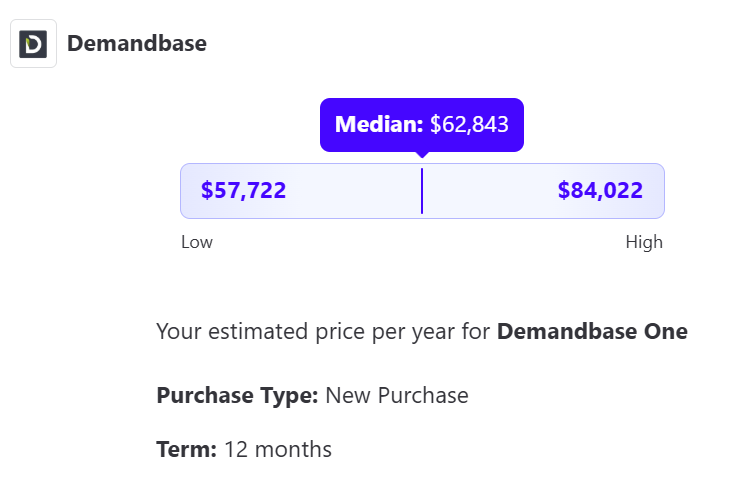
- Smaller organizations near 200 employees have reported paying about $18K to $32K for limited access, mid market companies with around 1,000 employees often land between $40K and $60K, and large enterprises can exceed $100K.
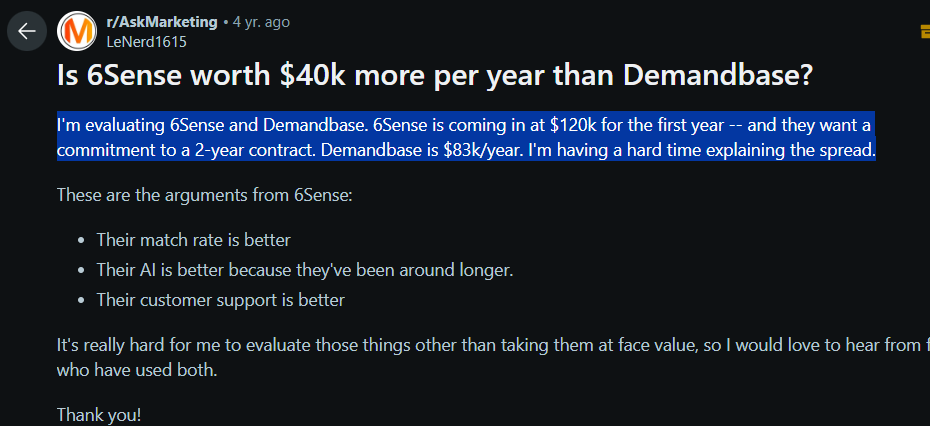
Join the Reddit discussion here 🙂 - Some advisors note enterprise contracts can range from $70,000 up to $300,000 per year for larger rollouts, depending on scope and add-ons.
When reviewing quotes, external benchmarks can help you validate fairness and avoid overspending.
Optional add-ons, such as extra intent data sources or sales intelligence databases, can increase the total.
Because of its breadth, many small businesses consider Demandbase more than they need.
They risk paying for modules that go underused.
In short, Demandbase suits teams with sizable ABM budgets and a mature program in place.
Common Room Overview: Key Features, Pricing, and More
Common Room is a customer intelligence and ABM platform that aggregates signals from many sources to present a 360 degree view of prospects.
The name fits.
It creates a “common room” where inputs from web traffic, product usage, community interactions, and more live together.
Unlike many ABM platforms, Common Room takes a person-first approach.
Let’s look at its key features:
Massive Signal Integration
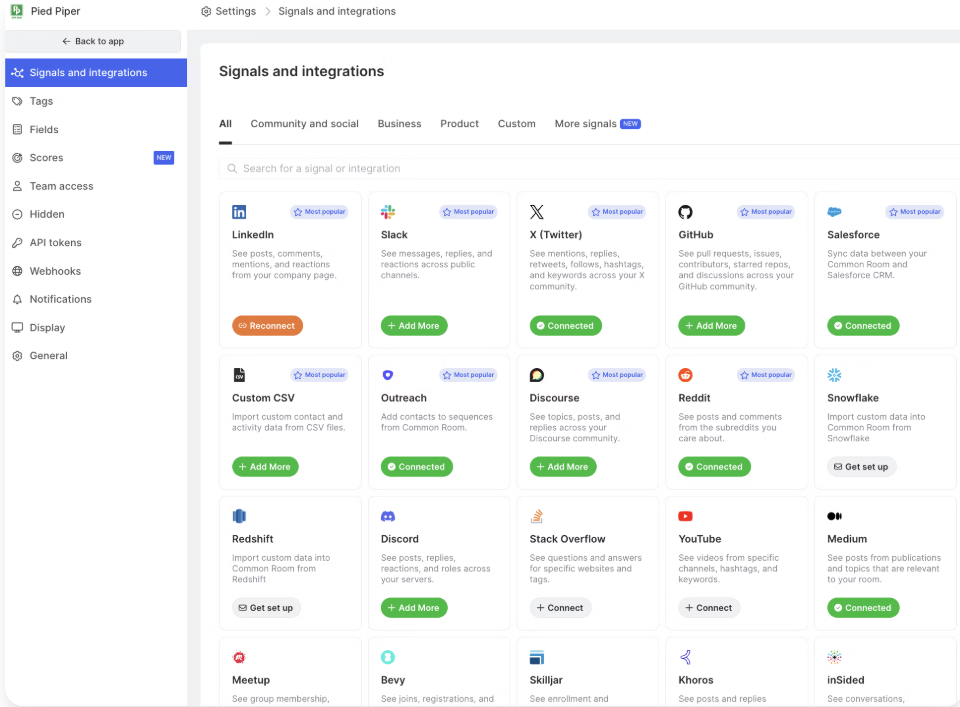
Common Room ingests buying signals from 50 plus native integrations across social, community, CRM, product analytics, and more.
These include Slack, Discord, GitHub, LinkedIn, Twitter, Salesforce, HubSpot, Marketo, and platforms such as G2 and Stack Overflow.
All integrations are code free, which makes connecting data sources straightforward.
AI-Powered Identity Resolution (Person360™)
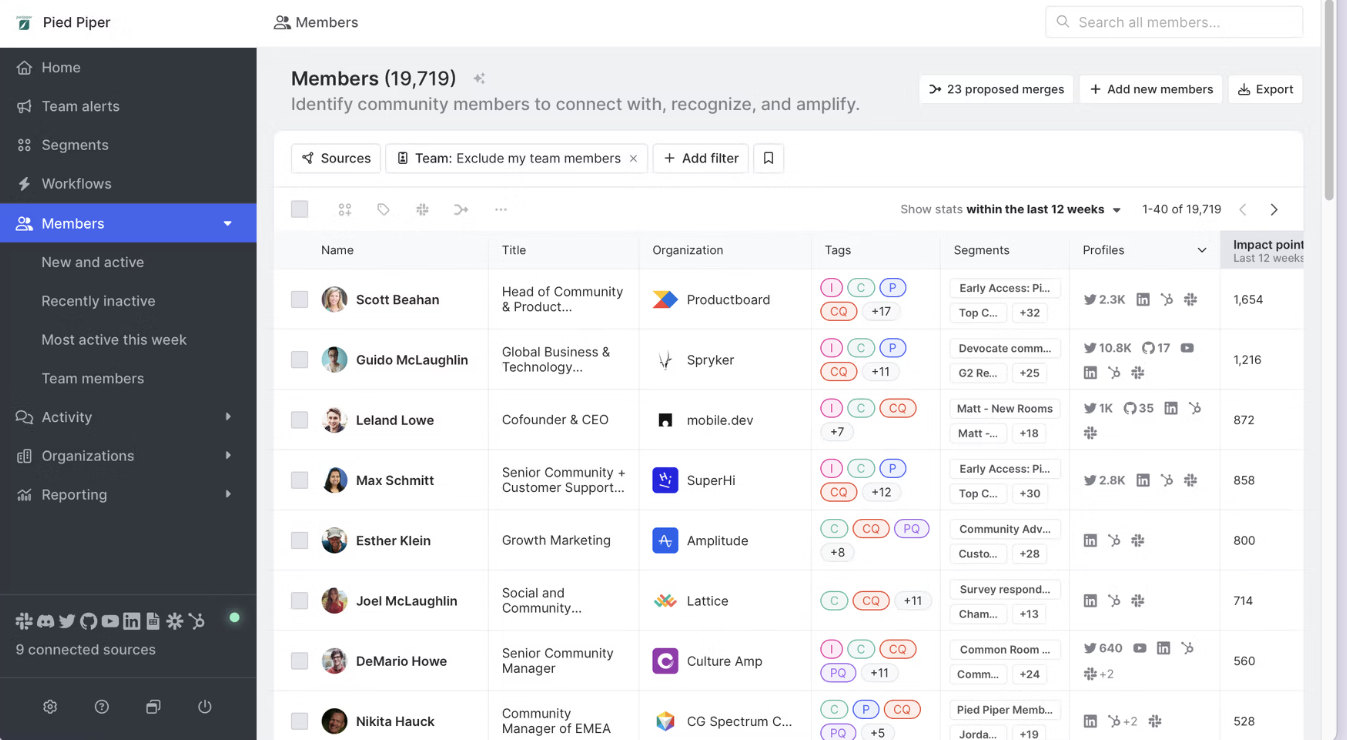
Once data is flowing, Person360™ merges activities into unified contact and account profiles.
It uses advanced matching beyond email to deduplicate and link identities across channels, and flags uncertain matches for human review.
This produces one reliable profile for each person.
For instance, it can connect an anonymous website session to the same user’s Slack and GitHub presence once identified.
After identity resolution, a waterfall enrichment process adds firmographics and technographics (company size, industry, tech stack, and more) from data partners, refreshed daily.
Lead & Account Scoring
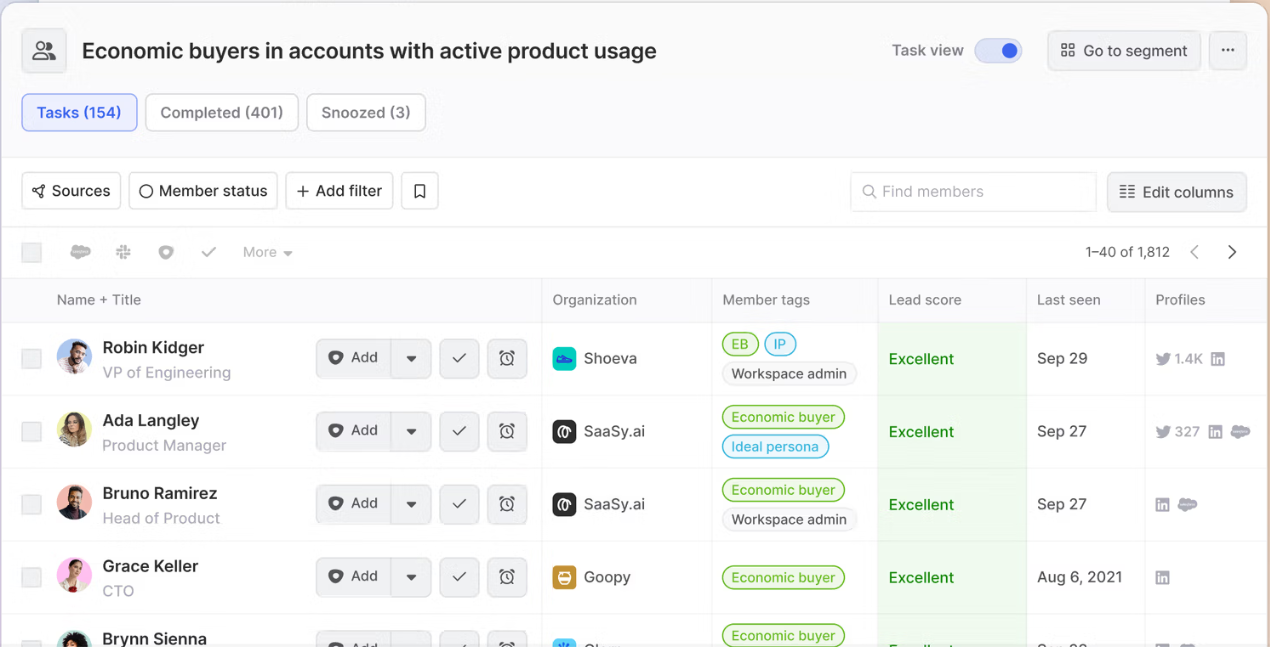
Common Room’s AI (RoomieAI™) filters and scores leads based on fit and intent.
You can define custom scoring models that blend any signals (for example, job seniority, product usage frequency, community contributions) with firmographic rules.
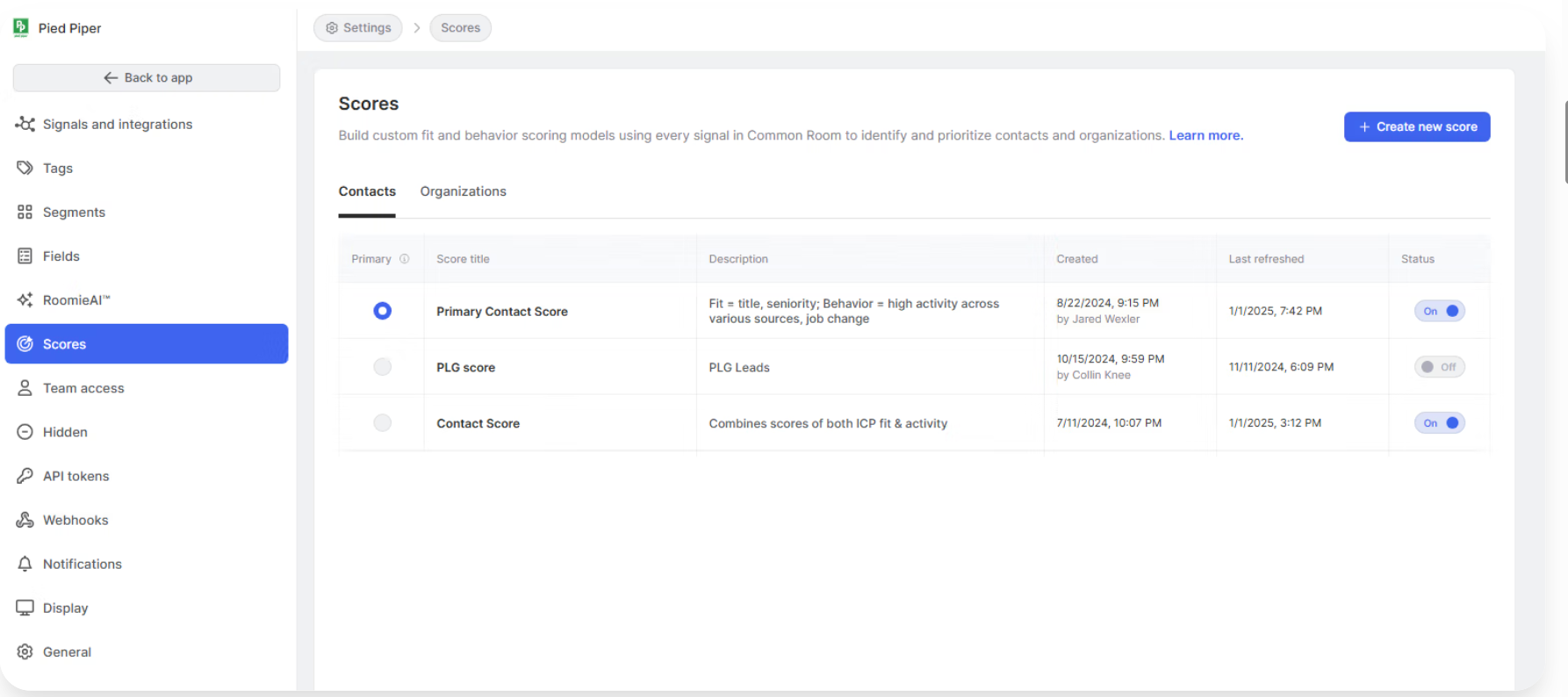
The platform supports hundreds of buying signals as inputs to scoring, from email opens and form fills to GitHub stars and G2 visits.
Scores exist at both contact and account levels so reps get prioritized lists of high fit, high intent targets.
For example, Notion’s team tags “high fit” accounts and triggers Slack alerts whenever those accounts show buying behavior.
By the way, ZenABM also supports account scoring from LinkedIn ad engagement:

So, if your ABM motion is LinkedIn led, you may want to try ZenABM.
Prospector Database
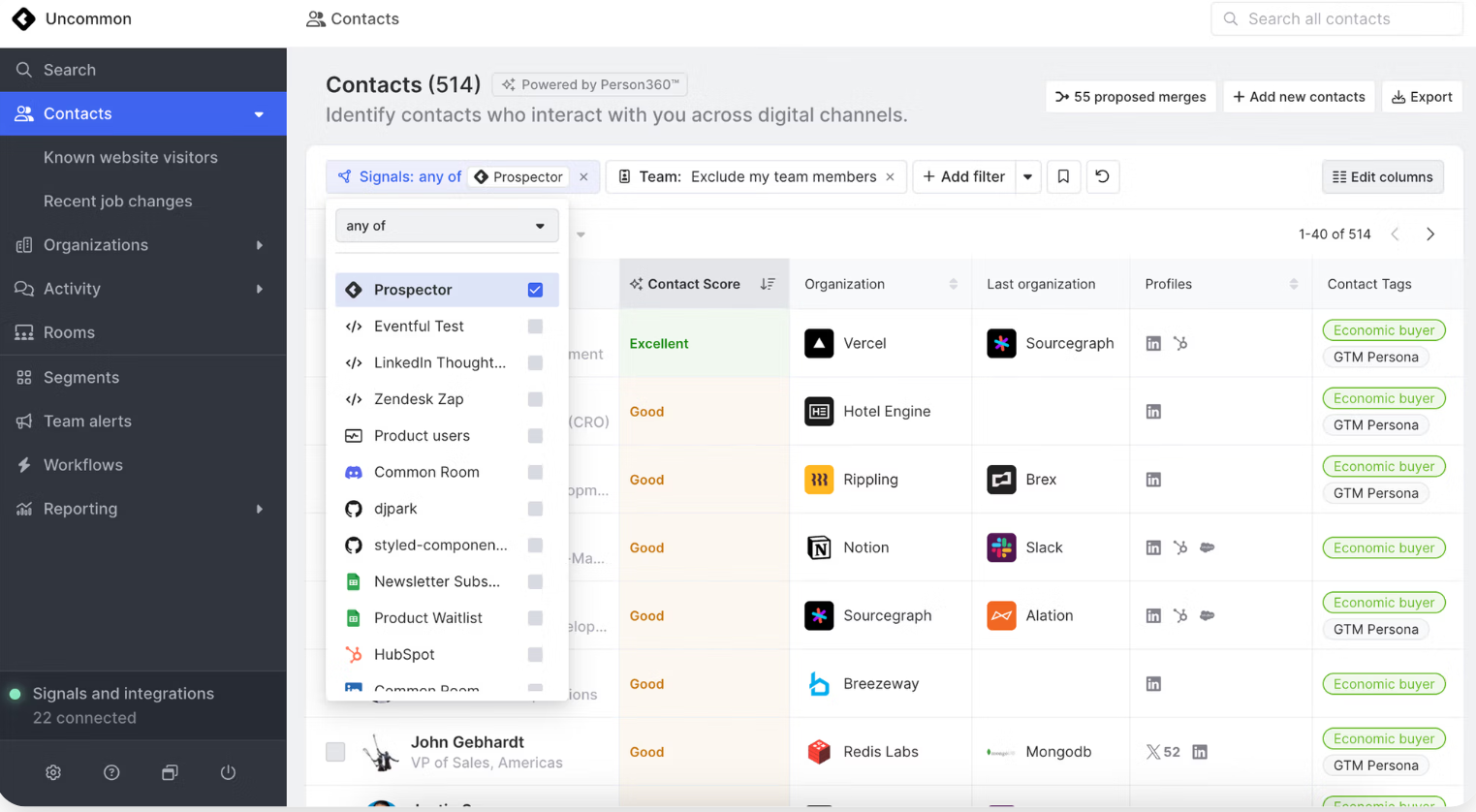
Beyond internal data, Common Room includes a prospecting tool tied to a database with more than 200M contacts.
Enter ICP filters such as industry, role, and company size, and it will suggest new accounts and contacts that match, with scores from third party enrichment.
This helps you find lookalike prospects you might otherwise miss.
Website Visitor Tracking
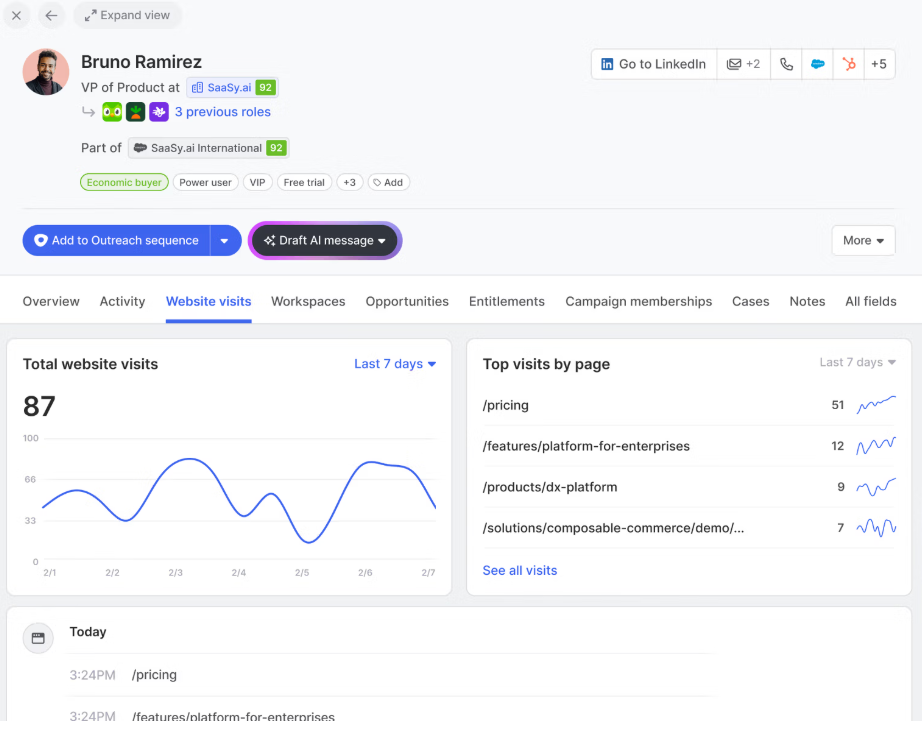
Common Room identifies anonymous web activity at the company level.
With a first party cookie and IP lookup, it can reveal which business a visitor is from even before they submit a form.
When that visitor converts, prior browsing is attached to their profile.
This shows whether someone from a target account was checking the pricing page or docs before they reached out.
Pro Tip: About 42% (as one study reported) is where IP based visitor identification tends to top out for accuracy.

ZenABM recommends using low cost LinkedIn text ads targeted to your site visitors as a way to reveal interested companies.
Text ads on LinkedIn have very low click rates, so they are inexpensive to serve, and ZenABM shows which companies frequently saw those ads, indicating employees from those companies likely visited key pages.
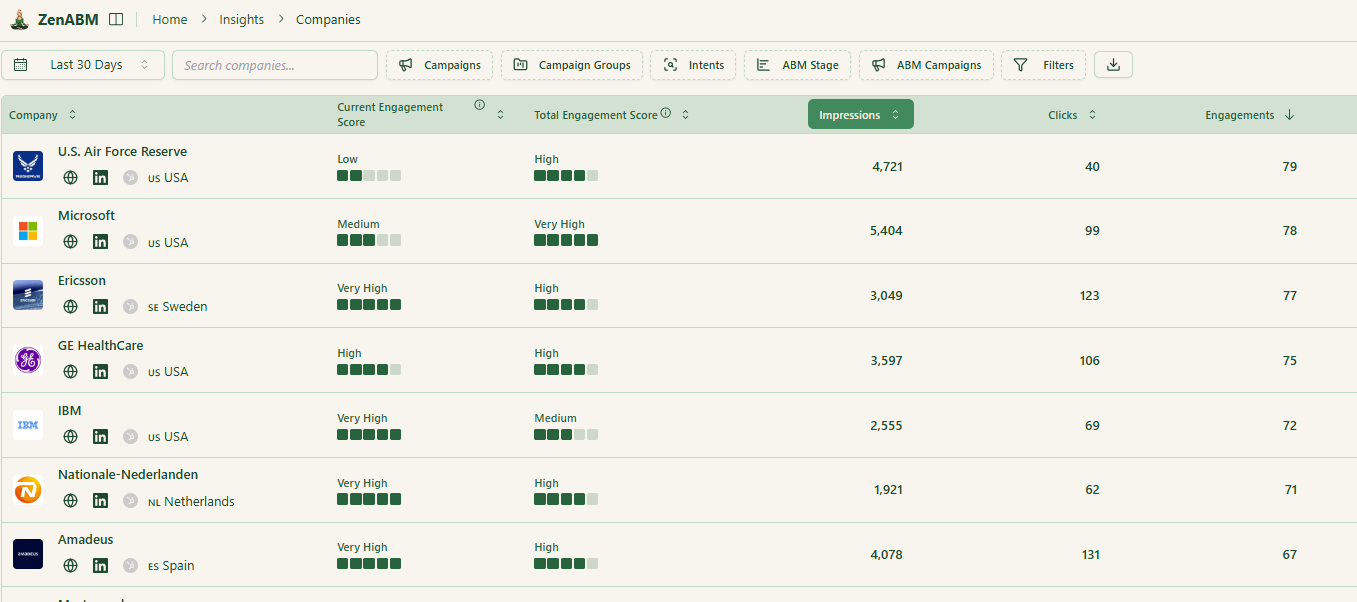
This first party deanonymization tactic can identify engaged accounts more reliably than fuzzy IP matches and at almost no cost.


Community & “Dark Funnel” Insights
A standout capability in Common Room is deep coverage of community and developer channels, the dark funnel where prospects engage before formal sales.
It integrates with Slack, Discord, Discourse forums, GitHub, Reddit, and more to surface meaningful actions.
For example, if an engineer at a target account posts in your community or stars your GitHub repo, Common Room records it and attributes to the person and the company.
Sales can then follow up with context.
For instance, “Saw you explored our GitHub project, can I help with anything?”
Workflow Automation and Alerts
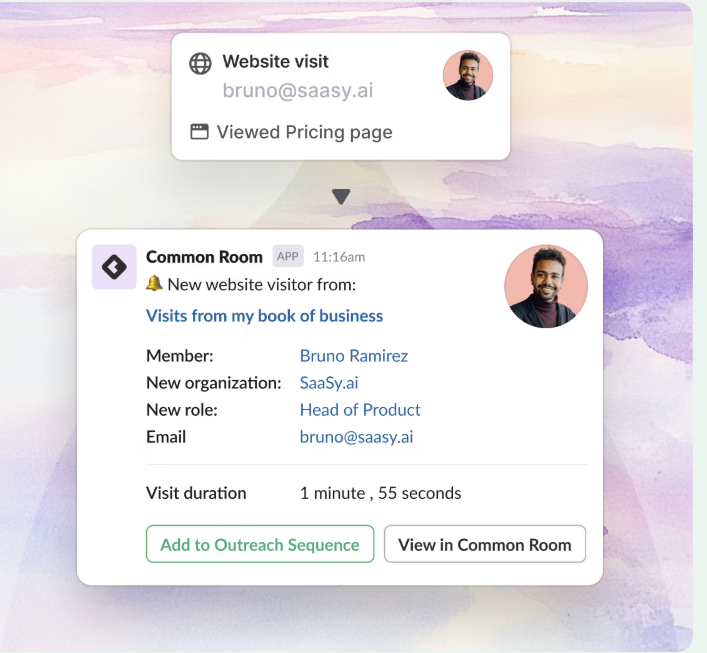
Common Room includes automation to act on insights.
Team Alerts let you set near real time triggers.
There is also a no code workflow builder to create multi step automations.
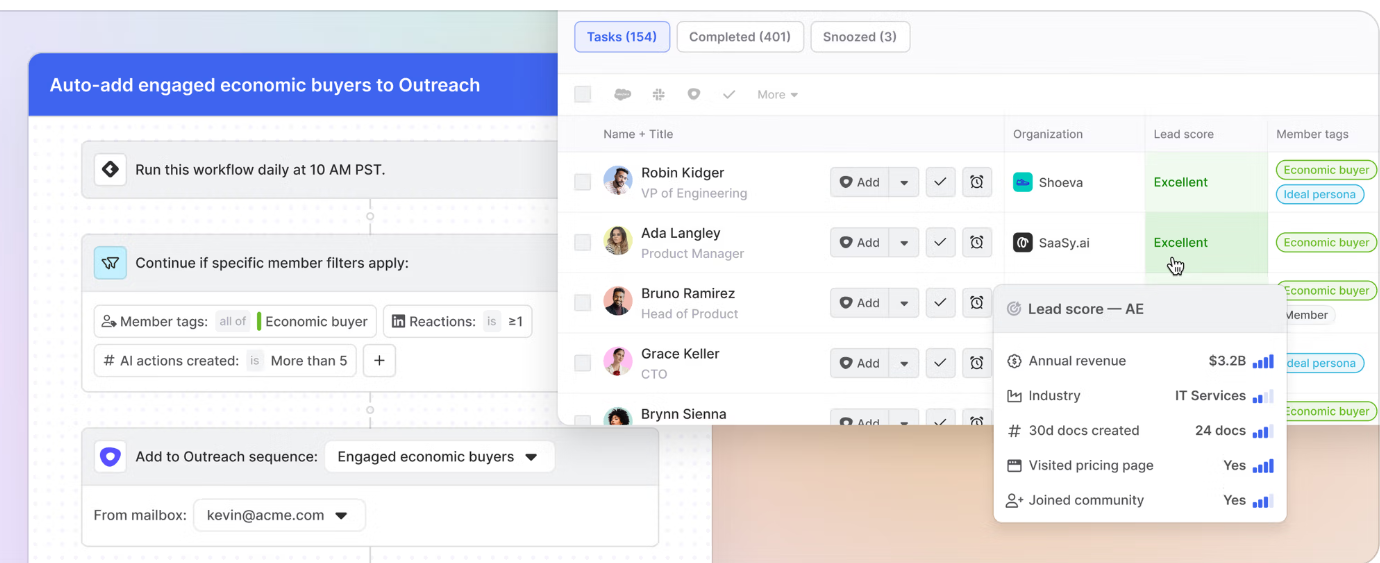
AI Outreach Assistant
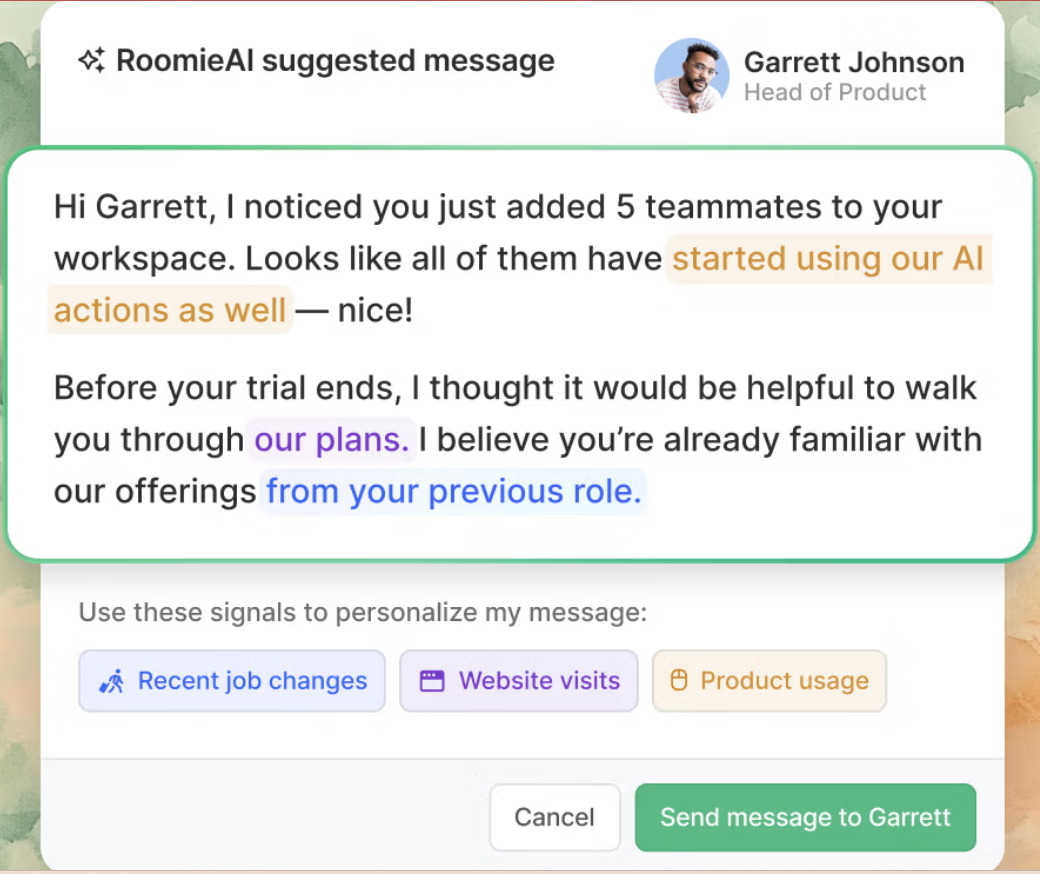
To complement its insights, Common Room includes RoomieAI™ Activate.
It serves as an email writing assistant for sales.
It can craft personalized outreach based on each prospect’s signals and context.
Note: G2 indicates mixed experiences with AI generated copy, with some users finding the messages generic or light on personalization.
Integrations Ecosystem
Common Room connects natively to a wide range of tools so it fits into your stack.
Its integration list spans CRMs (HubSpot, Salesforce), marketing and sales tools (Marketo, Outreach, 6sense, Demandbase, and others), data warehouses (Snowflake, BigQuery), community platforms (Slack, Discord, InSided), and more.
For details, see Common Room’s Docs.
Common Room Pricing
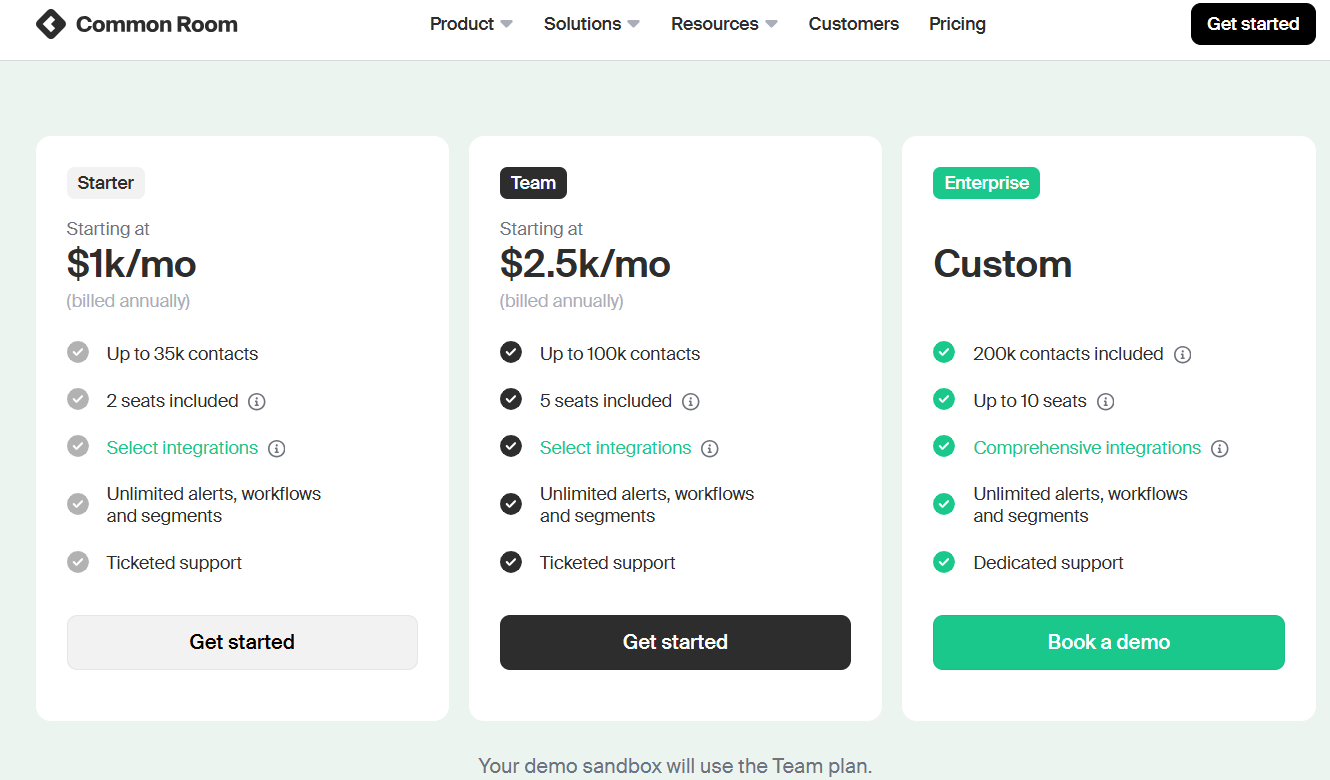
Common Room is a premium B2B platform, with pricing that scales by contacts and user seats.
The entry Starter plan (about $1,000 per month billed annually) includes roughly 35,000 tracked contacts and 2 user seats, along with core integrations and unlimited alerts and workflows.
The Team plan (around $2,500 per month) increases limits to about 100,000 contacts and 5 seats.
Both tiers include most core features such as visitor tracking, Person360 enrichment, and workflow automation.
An Enterprise option (custom pricing) supports 200K plus contacts, 10 plus seats, advanced integrations like full Salesforce data sync and custom objects, and dedicated support.
A free trial is also available on the Team tier without a credit card.
Demandbase vs. Common Room: Key Differences
Here are the major differences between Demandbase and Common Room you should consider:
| Category | Demandbase One | Common Room | Verdict / Key Insight |
|---|---|---|---|
| 1. Scope & Core Focus | Enterprise-scale GTM and ABM platform positioned as “pipeline AI for growth at scale.” Brings together data, insights, and actions across marketing, sales, advertising, and success. |
Signal and intent intelligence focused on mapping account-level intent to person-level context. Tracks community, product, and social activity signals. |
Demandbase = broad orchestration for the GTM stack. Common Room = focused signal intelligence layer. |
| 2. Pricing & Target Market | Custom enterprise quotes only. Estimated median near ~$62K per year. Smaller configurations may begin around ~$18K per year. |
Transparent tiering: • Starter: about $1,000 per month (~$12K per year) for 35K contacts • Team: about $2,500 per month (~$30K per year) for 100K contacts • Enterprise: Custom |
Demandbase = built for enterprise budgets. Common Room = growth and mid-market teams. |
| 3. Data & Signal Types | Combines first and third-party data (firmographic, technographic, intent). Includes its own DSP for ads plus website personalization. |
Emphasizes non-traditional signals such as community engagement, product usage, and social or open source interactions. Maps these signals to accounts and contacts for outreach. |
Demandbase = classic ABM funnel coverage. Common Room = community and behavioral signal depth. |
| 4. Feature Depth & Complexity | Comprehensive suite with campaign orchestration, personalization, DSP, and buying group identification. Rich functionality often means a steeper learning curve. |
Prioritizes surfacing intent and activity at contact and account levels. Lighter than full ABM suites, though onboarding is still required. |
Demandbase = depth with complexity. Common Room = specialization with usability. |
| 5. Use Case & Fit | Best for large ABM programs that need end-to-end orchestration across ads, web, and sales. Suited to mature GTM teams with dedicated ops and larger budgets. |
Best for teams watching community, social, and product-led signals. Complements existing orchestration, quicker to deploy, and more cost-efficient. |
Demandbase = enterprise ABM engine. Common Room = agile signal first GTM layer. |
So, Which is Better for Account-Based Marketing?
The right choice depends on your ABM maturity, budget, tech stack, and the signals you value.
- Choose Demandbase if: you are an enterprise or large mid market B2B operating across multiple channels (ads, web, personalization), you have dedicated ops or RevOps resources, you need end to end orchestration, and you can work with higher costs and a longer ramp.
- Choose Common Room if: your emphasis is less on broad channel orchestration and more on signal intelligence (community usage, product behavior, social engagement), you want fast time to value, you are cost sensitive, and you already have some advertising or personalization stack in place. It also shines if organic social is a core part of your brand motion.
- If your team is lean and anchored in LinkedIn ads or a small set of channels, consider a lighter option such as ZenABM (LinkedIn first, first party ad engagement, CRM sync) for quicker deployment and lower cost.
ZenABM as a LinkedIn-First, First-Party Lean ABM Alternative
Both Demandbase and Common Room are substantial platforms that serve broad ABM needs.
ZenABM takes a lean and focused path for ABM, aimed primarily at LinkedIn advertising driven strategies.
It is positioned as a lighter and more affordable option, especially for teams that do not need full multi channel suites, but want better visibility and automation around LinkedIn centric ABM.
Its key features:
Account-Level LinkedIn Engagement Tracking

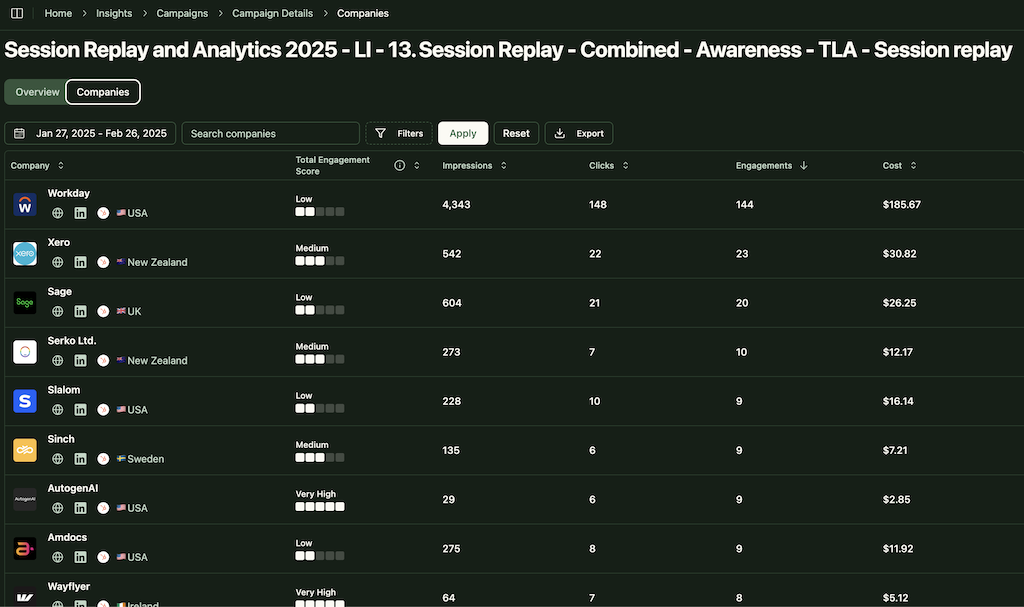
ZenABM connects to the official LinkedIn Ads API to ingest account level data for each LinkedIn ad campaign.
You can see which target accounts are engaging with your ads (impressions, clicks, and more) with attribution at the account level.
Because this is first party data sourced directly from LinkedIn, accuracy is high. In comparison, many larger ABM suites rely on cookies or IP matching to guess the visiting company.
A study by Syft found that IP based web visitor identification accuracy tends to top at about 42%.

ZenABM delivers qualitative intent from ad engagement, so if multiple people from a company are clicking or reacting to your LinkedIn ads, you get a clear signal of interest without paying for third party intent feeds.
Real-Time Engagement Scoring

ZenABM computes an engagement score for each account based on LinkedIn ad interactions and keeps it updated.
You can view current engagement to spot which accounts are heating up now, and track historical engagement trends.
This helps sales prioritize outreach.
ABM Stage Tracking

ZenABM lets you define the stages in your account journey (for example, Identified, Aware, Engaged, Interested, Opportunity).
It uses engagement scores plus CRM data to assign each account to a stage automatically.
The best part is that you can customize thresholds for what qualifies as Engaged or Interested, and ZenABM tracks movement across stages.
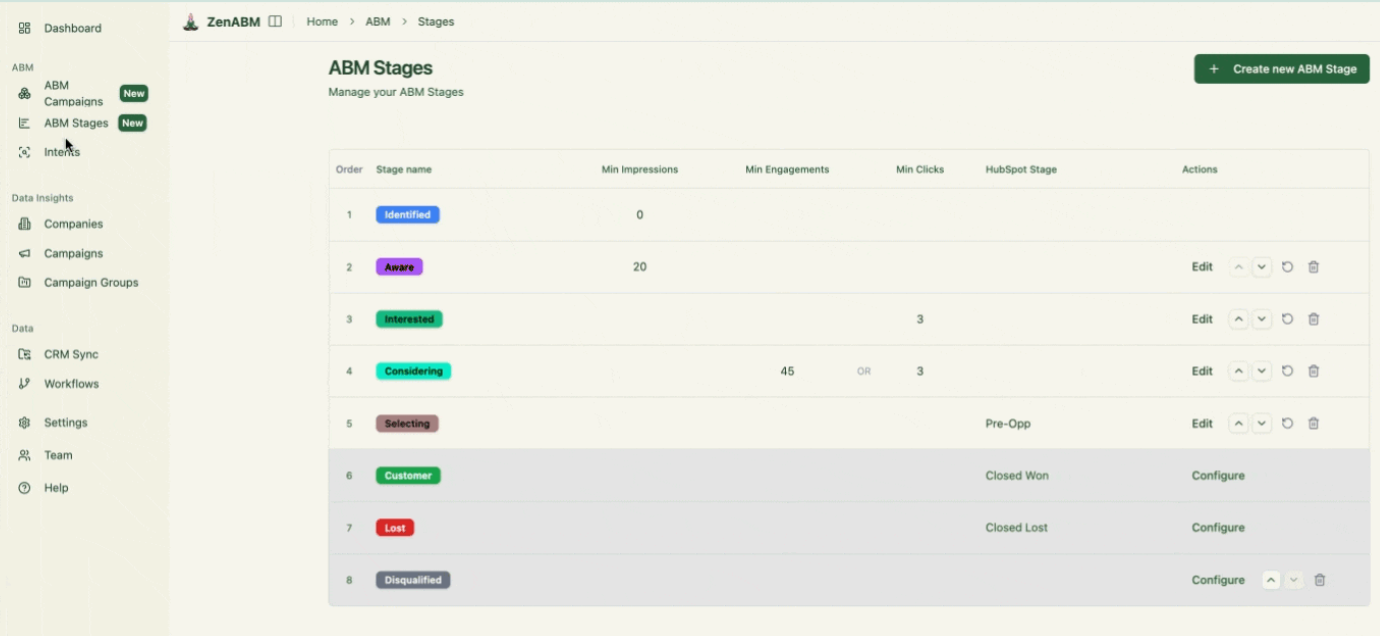
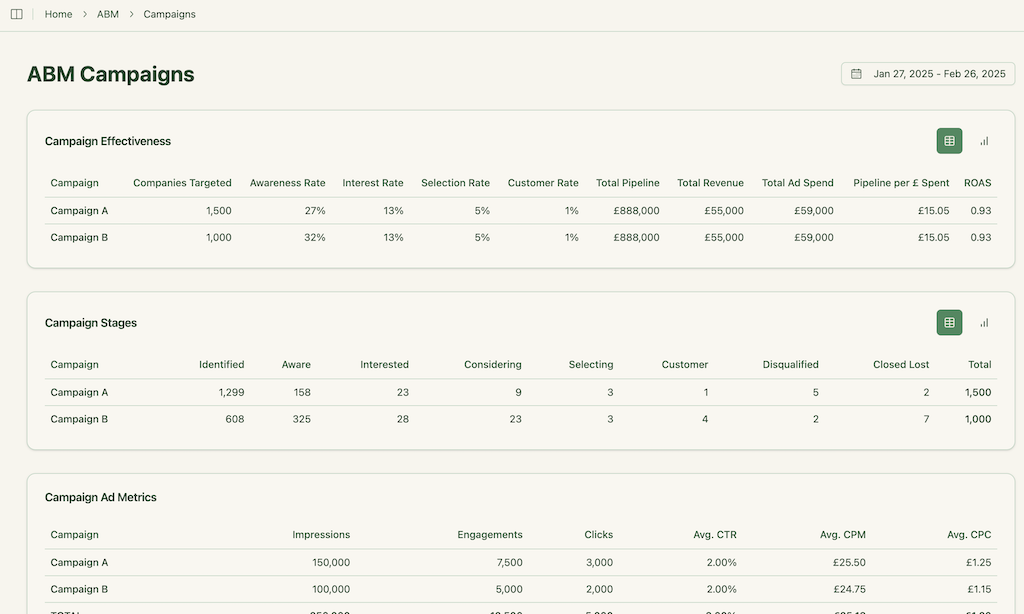
This delivers funnel visibility similar to larger platforms. You can spot where accounts stall and fix gaps in your program.
CRM Integration and Workflows
ZenABM syncs both ways with CRMs such as HubSpot, and Salesforce on higher tiers.
LinkedIn engagement metrics can be pushed into the CRM as company properties:
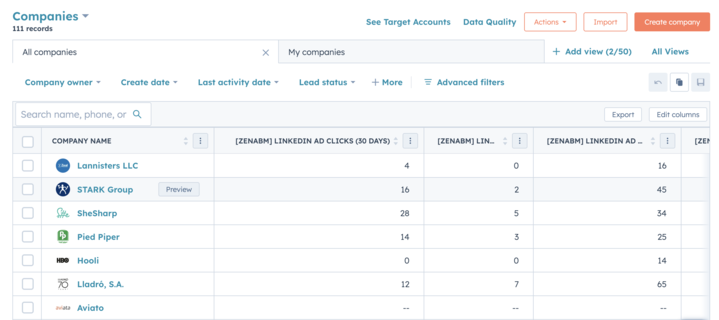
ZenABM also updates an account to Interested in the CRM once a score threshold is crossed, and can auto assign a BDR for timely follow up.

Intent Tagging from Ad Engagement
ZenABM provides a method to infer intent topics from your LinkedIn campaigns. Tag each campaign with a theme or value proposition, and ZenABM reports which accounts engaged with which themes.
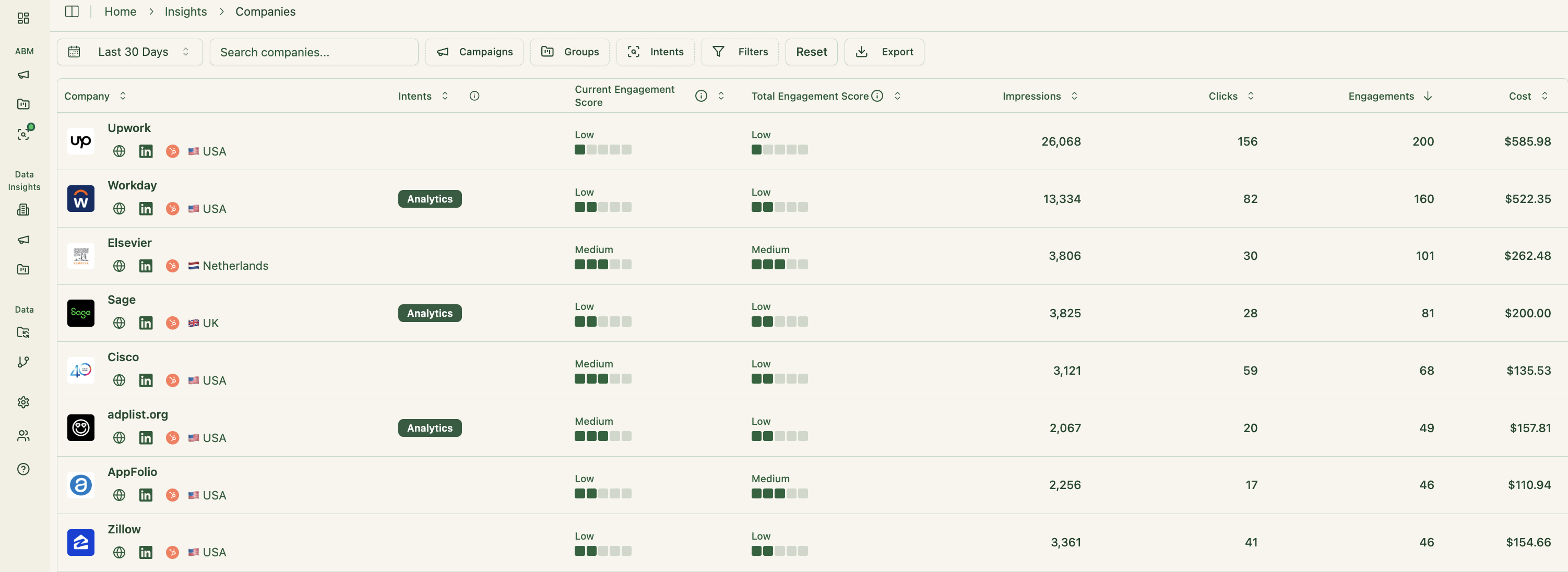
This is first party intent, since it is based on real engagement with your message rather than inferred keyword surges.
These intent fields can be pushed to CRM, enabling targeted outreach and better timing.
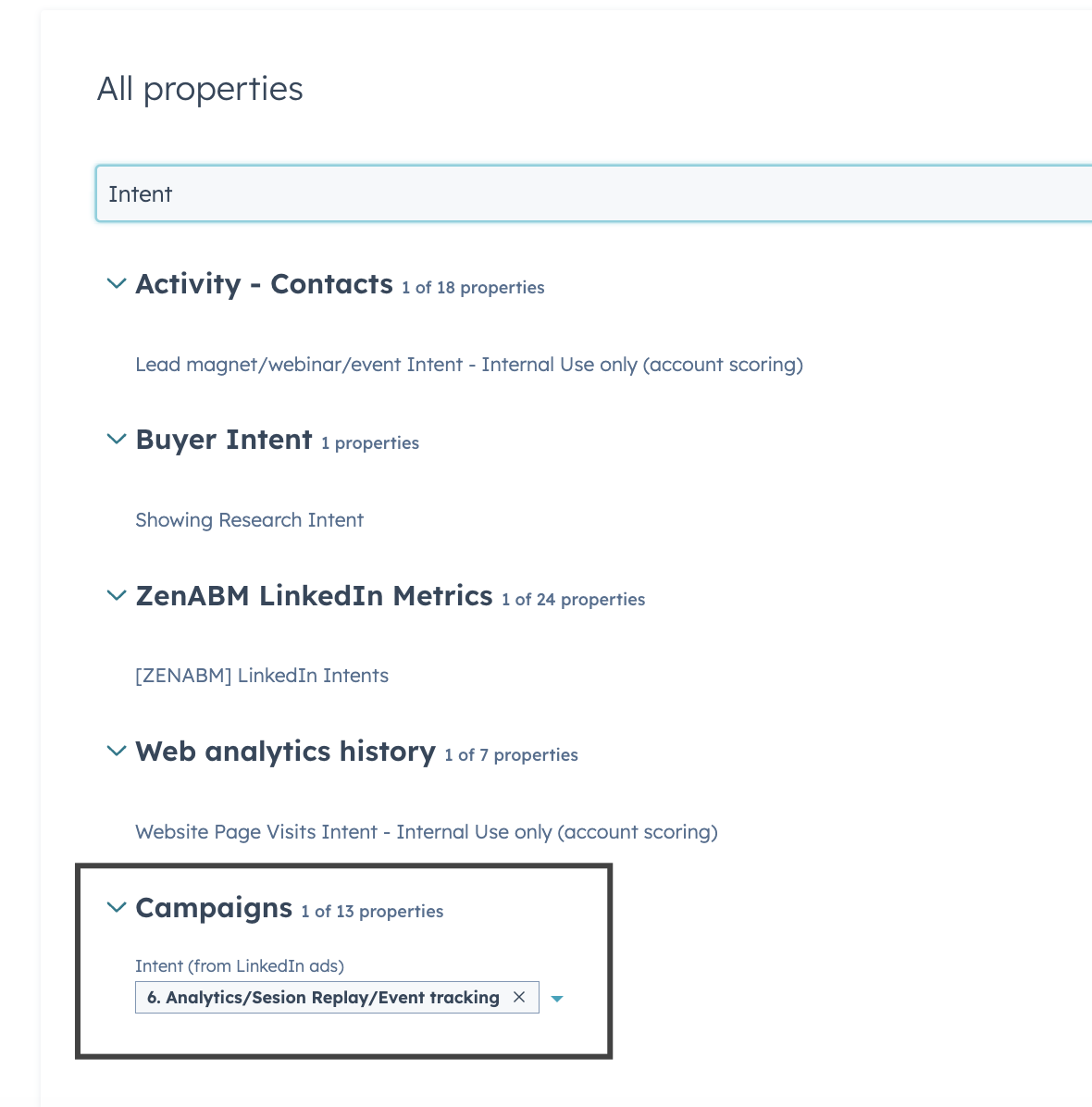
The benefit is simple.
Reps can tailor messages knowing exactly what each account cares about.
Built-in Dashboards and ABM Analytics
ZenABM ships with ABM dashboards that connect your LinkedIn ad exposure to account engagement, stage movement, and pipeline impact.
- You can view performance at every level, including ABM campaigns, LinkedIn campaign groups, and individual LinkedIn ad campaigns:
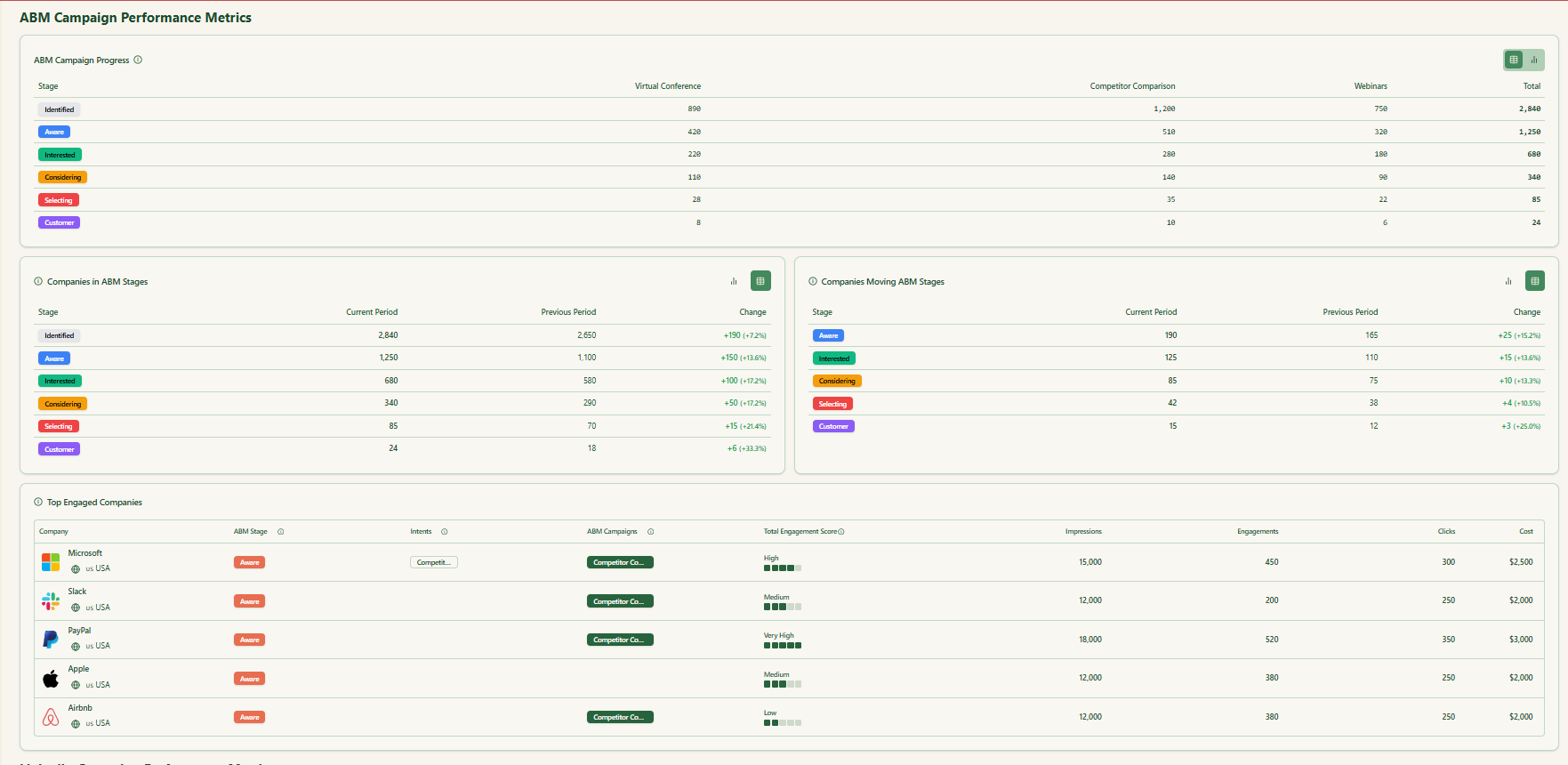

- Because it has both deal value and ad spend at the company and campaign level, it calculates revenue metrics and effectiveness metrics such as ROAS and pipeline per dollar, and presents a visual pipeline. ZenABM emphasizes actionable metrics tied to revenue rather than vanity numbers.

Custom Webhooks
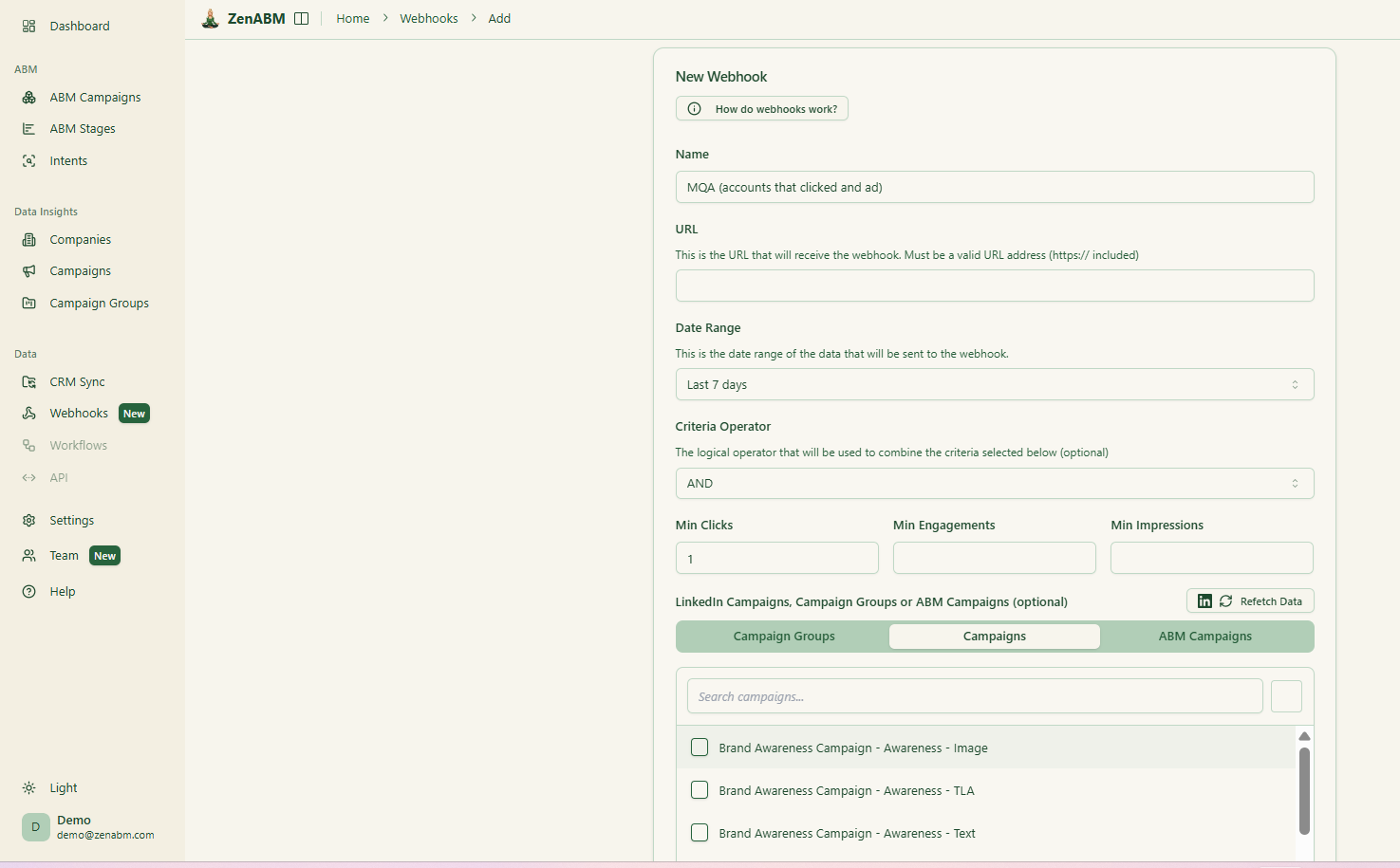
With ZenABM’s custom webhooks, you can place ZenABM events wherever you need them in your workflows.
ZenABM Pricing
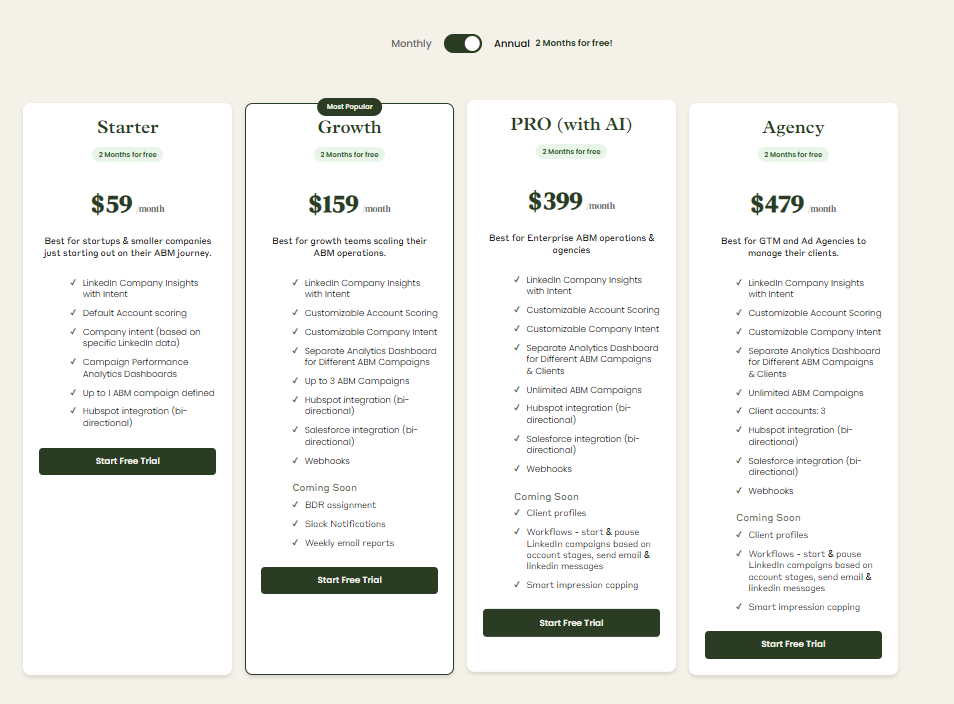
Plans start at $59 per month for Starter, $159 per month for Growth, $399 per month for Pro (AI), and $479 per month for the Agency plan.
Even the highest plan stays under $6,000 per year, far more affordable than Demandbase and Common Room.
All plans include core LinkedIn ABM capabilities.
Higher tiers mainly expand limits and add Salesforce sync.
Monthly and annual options are available, plus a 37-day free trial to evaluate the platform.
Conclusion
Demandbase and Common Room serve different needs within ABM.
Demandbase provides full-stack power for enterprises that want unified orchestration across advertising, personalization, and pipeline attribution, though that breadth comes with complexity and cost.
Common Room reframes intent by pulling community, social, and product usage signals, which suits teams that value signal intelligence over traditional campaign execution.
For lean LinkedIn first marketers, ZenABM bridges the gap, offering first-party LinkedIn engagement, real-time scoring, and CRM alignment without enterprise overhead or six-figure pricing.

